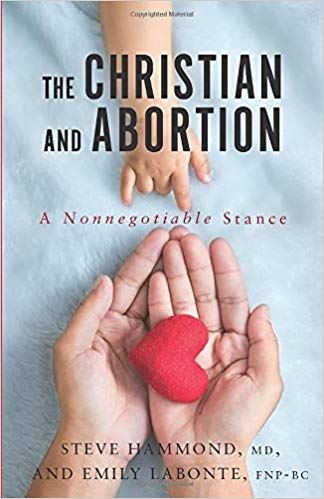When Does Life Begin?

In our new book, The Christian and Abortion: A Nonnegotiable Stance (Credo House Publishers), we seek to provide medically-sound and crystal-clear answers to some of the most important questions surrounding this highly controversial topic.
So, when does a human being’s life begin?
All but the most ardent supporters of abortion will agree that a baby who is inside its mother’s body is considered a human being just a few seconds before birth. The reasons most would say this are based on logic and experience.
In the moments before birth there is always anticipation. What will she look like? Will he look like the mommy or the daddy? Whether the moments are before birth or after birth, a mother or father will consider the baby to be a human being.
After all, what does a woman say after she has a pregnancy loss? She says, “I lost the baby,” not “I lost the fetus.” This is because the experience of every woman is that if she is pregnant, then she is carrying a life.
What if the baby is unwanted?
What, you may be asked, is the difference if the mother and/or father does not want the baby? Does calling it something else change what it is?
Sadly, our culture has tried to draw a line of distinction in which a desired fetus equates to a human being but an undesired fetus does not.
In reality, no such line exists, but proclamations that it does make the decision to support abortion on demand much easier.
Why is there a distinction between before and after birth?
Why, then, do ardent abortion supporters claim that a moment before birth the baby is not a human being and, therefore, is without rights?
The obvious answer is that if the baby has rights, then the high court’s decision to allow its destruction is turned upside down and would have to be reconsidered. For this reason alone, you likely will never convince an abortion rights activist to agree that a moment before birth a baby is a human being, but this is an excellent place to start.
I would ask them, “What happens to make the baby a human being at the moment it takes a breath?” This is a question without a clear answer because there is nothing other than the court’s arbitrary decision to deem it to be so.
What’s more, Is there a clear point at which the substance of what is inside the womb changes? When does the fetus-to-human transformation take place?
Let’s look at all the points along the process of intrauterine development to see if we can determine a clear point of demarcation:
A common claim is lack of viability.
The most common point to which many abortionists might agree is that when a baby is viable outside of the womb, they would not support an abortion. After all, they may argue, even if we removed a baby at a certain gestational age, it could not survive outside of the womb on its own.
This is a pragmatic and non- scientific answer to the question because viability is not a static point in time.
Viability is possible at early gestation.
As a point of reference, my youngest son was born at 26 weeks in 1982. There was little hope that he would survive at that gestational age in 1982, but he beat all the odds and not only survived but is a computer genius today.
Due to advances in medicine, the prospect of survival is much greater at 26 weeks today than it was then. Viability is dependent on the level of medical expertise to care for the extremely premature infant. However, from a medical standpoint, viability is also not associated with a dramatic alteration or change in the structure of the baby in utero.
I would argue that the baby didn’t go from being nonviable outside the womb on April 22 to being viable on April 23. The viability argument is designed only to placate those who would say that only a viable baby should not be destroyed. It does not answer the question of when the baby becomes a human life.
Viability always requires care.
I would also add that a newborn of any gestational age requires care and nourishment from a parent to live. If you take the healthiest full-term baby girl or boy and ignore its needs for food and shelter, it would not survive.
Thus, viability outside the womb does not end with birth. Furthermore, neglecting to meet the needs of a newborn can be considered murder by the courts.
Some point to an arbitrary ‘quickening’ as the beginning of life.
Beyond viability, another developmental milestone that some may point to when describing when life begins is the point of quickening, or the mother’s recognition of a baby’s movement inside her.
This is also arbitrary, as some women feel this occur at 14–15 weeks, while others may not feel it until 20–22 weeks or later. Fetal movement is seen on real-time ultrasound as early as 7–8 weeks, so perception by the mother is certainly not the first movement of the baby, but only the first perceived movement.
Furthermore, movement is only a characteristic of the neuromuscular development of the baby, not a landmark for determining its humanity.
Some say life begins upon implantation of a fertilized egg.
Implantation is another point of development that people may reference. This is the point at which the fertilized egg or zygote burrows into the uterine lining to get nourishment.
If implantation does not occur, the fertilized egg will not survive. Indeed, there is not a pregnancy test available that would tell you that a woman was pregnant before implantation, since the pregnancy hormone HCG is not produced in the mother until a few days after this event.
Implantation does not change the internal structure of the fertilized egg in any way and, therefore, could not be considered a point of demarcation from inhuman to human.
Since there would not be a positive pregnancy test at this point, no one would seek an abortion at this stage of development regardless. The only reason to debate this point in the first place is in defense of the morning-after pill, which is a high-dose hormone designed to make conditions hostile for theimplantation of a fertilized egg.
If implantation were the undisputed point of conversion from inhuman to human, then there would be no real objection to the use of ‘morning-after’ birth control. However, implantation is only a step along the way, and though it is a necessary step, it does not alter the substance of the developing embryo.
I would even argue that prevention or disruption of implantation is just as much an abortion as destroying a baby moments before delivery!
Life begins at conception. There are many points to defend this position.
The most logical and scientifically defensible answer to the question of when life begins is conception.
First, prior to conception the sperm and the egg have only half the number of chromosomes found in all other human cells.
Once they connect, the full complement of chromosomes—23 from the egg and 23 from the sperm—combine to make 46 in the fertilized egg. This new entity is called a zygote, and it is different from all the cells of the mother and father.
In fact, except as in the case of identical twins, no other human being who has ever existed on planet Earth has the same chromosomal makeup as this particular zygote.
Uniqueness is only one aspect that differentiates this cell from all other cells of the mother and father.
The 46 chromosomes have the ability to direct the development of a new and unique human being from the very moment of conception. While there is usually only one egg produced by a woman each month, the male contributes millions of sperm, but only one of them actually fertilizes the egg.
Second, all human beings on this planet were once a single fertilized egg!
Clearly, in the case of people, conception results in a genetically unique zygote that will eventually result in a human being born. Prior to conception, no such potential exists.
Third, cells begin communicating right away.
Once fertilized, the egg begins to divide. First, one cell becomes two cells. Then, something very interesting happens.
For a very short time, there are three cells before the three become four. Molecular scientists have determined that as early as this three- cell stage, there is a “communication” between the cells that directs this ultimate differentiation of the zygote into all the cells necessary to create a unique human being.
If we were to take a cell from any living animal and stimulate it to replicate itself, it would split, and two would become four, which would then become eight, and so forth.
Fourth, at conception, this unique set of chromosomes is a genetically separate being from the mother.
If, at conception, a new being with a unique set of chromosomes on which there is unique genetic material is created, we must at least conclude that this new being is genetically separate from the mother who is carrying it.
Also, we can conclude that this new being—if not terminated—eventually can become an active adult human life.

Emily LaBonte, FNP-BC,is a board-certified nurse practitioner working for a large healthcare company in Las Vegas, Nevada. There she serves as a lead on the committee in charge of mentoring new providers hired into the company. LaBonte also is a member of the American Association of Pro-life Obstetricians and Gynecologists. LaBonte is the co-author, with Steve Hammond, MD, FACOG, of the landmark new book, The Christian and Abortion: A Nonnegotiable Stance (Credo House Publishers).
Photo Credit: ©GettyImages/RyanKing999
Originally published July 31, 2019.







